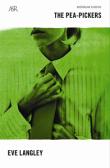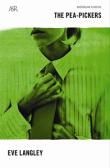AustLit
Latest Issues
AbstractHistoryArchive Description
'In The Pea Pickers, a novel based on Eve Langley's own experiences, Steve and Blue are two girls who, dressed as men, are taken on as itinerant workers for the farmers of Gippsland. They pack apples and pick peas. But their disguise is partial - and their quest is for love. For Blue the novel ends in marriage; but not for Steve. For her, desire is never straightforward, and love - for men, for women, for country - leaves her confused, but independent. ' (Publication summary)
Publication Details of Only Known VersionEarliest 2 Known Versions of
Works about this Work
-
y
 Eve Langley and 'The Pea Pickers'
Clayton
:
Monash University Publishing
,
2021
21004567
2021
single work
biography
Eve Langley and 'The Pea Pickers'
Clayton
:
Monash University Publishing
,
2021
21004567
2021
single work
biography
'Autobiography or fiction? This question has shadowed the work of enigmatic Australian author Eve Langley since her death in 1974. Was her writing the truth, or false, or somewhere in between? What did it mean when she described her father as ‘evil’ and ‘perverted’ in her first published novel The Pea Pickers (1942) and a kindly figure in later, unpublished work? Did she really believe herself to be Oscar Wilde? Was she gender fluid? Eve and her sister (and co-conspirator) June held onto family secrets as if their very lives depended on it. Eve Langley has been in the news since the 1920s and reviewed on both sides of the globe. She was an author, a wife, a mother, a sister, a daughter and a long-term psychiatric inmate. But June, who traversed the Australian countryside dressed as a boy, a willing lifelong companion to her beloved sister, is a lonely anonymous figure. Drawing on contemporary evidence, Eve Langley and the Pea Pickers gives the key players in the author’s life a voice, and the result is a fascinating but ultimately poignant tale of love and loss.'
Source: Publisher's blurb.
-
“Manufactured By The Sun” : Eve Langley’s The Pea-Pickers on The Move
2016
single work
criticism
— Appears in: Ilha Do Desterro : A Journal of English Language , vol. 69 no. 2 2016; 'Eve Langley’s The Pea-Pickers is often seem as a quaint artifact of a now-vanished Australia. This paper seeks to rescue the contemporary relevance of this novel of two young women who go into the rural areas of Gippsland to pick peas, showing its pioneering attention to transgender concerns, the polyphonic panoply of its style and soundscape,. and its portrayal of a settler culture not anchored in a perilous identity but dynamically on the move. As so often in settler colony literature, though, rigidities on the issue of race—particularly the portrayal of the Muslim migrant Akbarah Khan—mar the canvas, and make Langley’s novel as emblematic of the constitutive problems of Australian literary history as of its artistic achievements. Just as Langley’s gender variance and personal nonconformity made her an outlier in the Austrlaia and New Zealand she lived in, so is her contribution to Australian literature an unfinished project. ' (Publication abstract) -
The Pea-Pickers : An Introduction
2015
single work
essay
— Appears in: Westerly , vol. 60 no. 2 2015; (p. 106-113) -
Outsider Architecture : The Literary Constructions of Eve Langley
2013
single work
criticism
— Appears in: JASAL , vol. 13 no. 2 2013;'Outsider architecture references a continuum of unofficial constructions, from the tenuous envelope of found materials that a homeless person folds about themselves nightly, to the compellingly precarious sculptural artefact, painstakingly but illegally built, in a front garden or on public land. One way that the homeless deal with their vulnerability to harsh weather, psychological disturbance and lack of privacy is the construction of ad hoc shelters from found objects and recycled rubbish. These shelters represent one form of outsider architecture. Roger Cardinal notes that another form is the idiosyncratic construction of sculptural assemblages, also, typically from recycled materials, to form architectural structures, modified dwellings, landscaped areas, collections, monuments and shrines that seem to pop up in most cities, or anywhere there are people (169). All over the world, homeless people seek to provide at least temporary shelter for themselves, and at the same time, a certain number of people, sometimes the same people, engage in personal projects of construction in which the expression of individuality is as, if not more, important than physical containment or shelter.
'This article will consider the work of one author, Eve Langley, as a form of outsider architecture and will suggest that the physical entity formed by Langley’s novels, as a manifestation of outsider architecture, provided their author with the hope of psychic shelter when she wrote them. Langley wrote at a time in which it was difficult for a woman to succeed as an artist, or to support herself financially. As well, she experienced a dysfunctional marriage and suffered from uncertain health. Despite these difficult conditions, she wrote compulsively, sending manuscripts, one after another to her publishers, long after they had stopped publishing her work.
'Yet, the large body of unpublished manuscripts in the Mitchell speaks of more than the mental ill health that is frequently associated with Langley. Consideration of the debates active within the literary community of New Zealand at the time Langley was writing, and the nature and content of, in particular, her novelistic oeuvre, suggests that Langley may have been writing at least partly in response to local literary voices. Despite her peripatetic lifestyle and solipsistic tendencies, Langley was part of the community of writers living in New Zealand in the mid-twentieth century. Her writing was supported and criticised by it, and undoubtedly shaped by it. This article will consider the part this community played in Langley’s writing, the dual aspects of vulnerability and strength, feelings of alienation and centrality, exhibited in Langley’s authorial choices. By examining Langley’s body of work through the lens of outsider architecture, Langley’s prolific literary output in the face of a largely negative reception may be seen, not so much as the sign of a loss of control, but as a strategic, if eccentric, construction of an authorial presence.' (Author's abstract)
-
Invisible, Unacknowledged, but Ubiquitous : Nan McDonald Joins Angus & Robertson
2013
single work
criticism
— Appears in: Telling Stories : Australian Life and Literature 1935–2012 2013; (p. 77-83)
-
A Tract of Life
1989
single work
review
— Appears in: Australian Book Review , October no. 115 1989; (p. 5-6)
— Review of Nettie Palmer : Her Private Journal Fourteen Years, Poems, Reviews and Literary Essays 1988 selected work poetry prose criticism review autobiography biography ; The Pea Pickers 1942 single work novel ; White Topee 1954 single work novel ; But Not for Love : Stories of Marjorie Barnard and M. Barnard Eldershaw 1988 selected work short story -
The Backward Glance
1966
single work
review
— Appears in: Australian Book Review , May vol. 5 no. 7 1966; (p. 134-135)
— Review of My Brilliant Career 1901 single work novel ; The Pea Pickers 1942 single work novel ; The Long Prospect 1958 single work novel ; Bush Studies 1902 selected work short story -
Worthwhile Sortie into Literary Past
1991
single work
review
— Appears in: The Canberra Times , 24 November 1991; (p. 21)
— Review of Landtakers : The Story of an Epoch 1934 single work novel ; The Salzburg Tales 1934 selected work short story ; The Pea Pickers 1942 single work novel ; The Watch Tower 1966 single work novel ; Disturbing Element 1963 single work autobiography -
Letter to Shakspeare
1942
single work
review
— Appears in: The Bulletin , 6 May vol. 63 no. 3247 1942; (p. 3)
— Review of The Pea Pickers 1942 single work novel -
The Pea Pickers
1942
single work
review
— Appears in: The Bulletin , 3 June vol. 63 no. 3251 1942; (p. 2)
— Review of The Pea Pickers 1942 single work novel -
Can You Better This Book List?
1945
single work
column
— Appears in: Book News , August no. [1] 1945; (p. 3) -
The Centaur and the Cyborg : Abject Becoming on the Colonial Frontier
2007
single work
criticism
— Appears in: Southerly , vol. 67 no. 1-2 2007; (p. 211-225) -
The Pea-Pickers : Eve Langley (1904-1974)
2007
single work
criticism
— Appears in: Australian Classics : Fifty Great Writers and Their Celebrated Works 2007; (p. 154-158) -
y
 The Pea-Pickers by Eve Langley
Pymble
:
HarperCollins Australia
,
2001
Z1612087
2001
single work
criticism
The Pea-Pickers by Eve Langley
Pymble
:
HarperCollins Australia
,
2001
Z1612087
2001
single work
criticism
-
Assimilation, Unspeakable Traces and the Ontologies of Nation
1995
single work
criticism
— Appears in: Meridian , October vol. 14 no. 2 1995; (p. 229-254)
Awards
- 1940 joint winner S.H. Prior Memorial Prize
- Gippsland, Victoria,
- New South Wales,
- Queensland,
- Bush,





